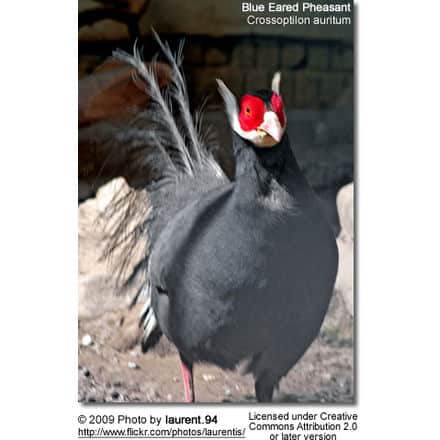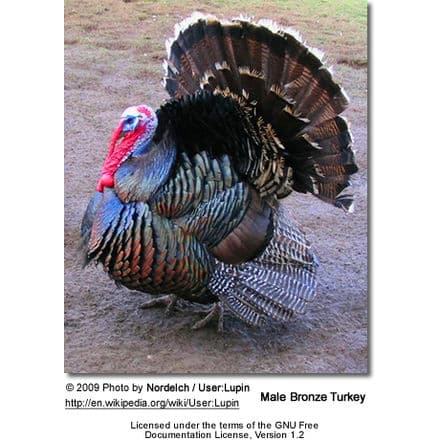Blue Eared Pheasant (Crossoptilon auritum)
The Blue Eared Pheasants (Crossoptilon auritum) is a monotypic species (a genus consisting of only one single species). It is found throughout mountain forests of central and western China.
These pheasants have adapted well to the high altitudes of mountainous regions of Asia. They occur in extreme northern Sichuan, Tibet and northward into Gansu in China in coniferous forests up to 11,500 feet (~3,500 meters).
This remote distribution explains why this species was the last of the three eared pheasants to arrive in the West when birds were sent t o the avicultural gardens of Jean Delacour at Clères in France in 1929.
One of the most common and stable eared pheasants, the Blue-eared Pheasant is not endangered or threatened at this time.


Description:
This is a large pheasant, up to 3.1 feet (96 cm) long. One of its distinguishing marks is the striking scarlet red bare facial skin. Its plumage is generally a dark blue-grey with a velvet black crown and long white ear coverts (feathers covering the ears) behind the eyes.
Its tail of 24 elongated bluish grey feathers is curved, loose and dark-tipped. The irides (= plural of iris) are red and the legs are crimson.
Both sexes look similar; however, the female is generally slightly smaller. Sexes can also be identified by looking at the spur. The spurs on the males are larger and round, while the female’s are much smaller and oblong in shape. The male also tends to have stronger legs and rounder, more extensive red wattles on the sides of his face.
Immature birds are mottled gray-brown and will attain adult plumage when they are about four months old. The spurs will be noticeable at that time also.
Call / Song:
Both sexes are very vocal and their calls can carry for over a mile. The male throws his head directly skywards and begins a series of harsh grating notes, often being answered by his mate or a rival male.
Diet:
They are great diggers and are seen digging and feeding on roots, sedges and bulbs. They use their huge bills, rather than their feet, to unearth tubers and insects. They also eat berries and other vegetable matters.

Keeping and Breeding the Blue-eared Pheasant
The Blue-eared Pheasants are the most common members of eared pheasants in captivity. Due to their hardiness and natural friendliness, they are generally easy to maintain.
The Blue Eared Pheasant often become quite tame in captivity and may readily eat out of their caretakers’ hands.
These pheasants are poor fliers so rarely need to be pinioned (pinion involves clipping the primary and secondary feathers of one wing, removing the bony part of the wing as well.)
They need to be provided with sufficient space, or else behavioral problems such as feather picking may develop.
Since this species is from the mountainous areas, cold weather is not a problem for them, but do make sure they have access to shelter during severe winter storms.

This species should be provided a spacious, well-planted aviary. Strategically place several large logs for perching. Make sure to incorporate shaded areas to shield them from the summer sun and adequate shelter to protect them from severe weather conditions.
Adequate dimensions might be 59 sq.ft. (18 m2) aviary. They have been bred in pens measuring 20 x 12 ft (6 m x 3.7 m).
Please keep in mind that they are sensitive to dampness, so it is important to place their pens on well-drained ground or to place several inches of sand on the floor.
They are heavy diggers and use their large, heavy bills to forage for grubs, insects and roots.
They will quickly destroy all plants in the aviary. It is better to use big and higher plants in the aviaries. Due to their digging, it is recommended to worm these Pheasants frequently.
Breeding:
These pheasants are usually of breeding age in their second year, although fertile eggs in the first year are possible. The breeding season commences in April and lasts until June.
They breed well in captivity and make attentive parents. The female lays 6 to 12 eggs that she incubates for 26 to 28 days.
Diet:
The Blue-eared Pheasants use their strong beaks to uncover insects, bulbs and roots, although they also eat seeds, leaves and, in captivity, are usually provided a base diet of pellets*. It is important to supplement greens in addition to providing them with their regular diet. *Please note: When feeding pellets, please be aware of the fact that overly feeding citrus fruits (including oranges) to your birds can lead to “Iron Overload Disease.”
Other Releated Web Links: Pheasant General Information … Pheasant Species … Pheasant Taxonomy … Breeding Pheasants … Pheasant Photo Gallery … Housing Pheasants … Pheasant Diseases





